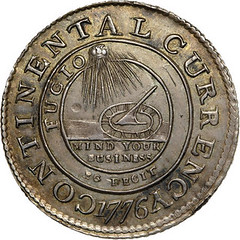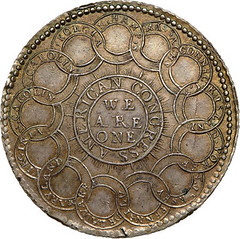
PREV ARTICLE
NEXT ARTICLE
FULL ISSUE
PREV FULL ISSUE
THE GRANBERG CONTINENTAL DOLLAR IN SILVER
The upcoming Heritage sale of Eric Newman colonial coins features many rarities. Here's just one - the finest known Continental dollar in silver. Below is text abstracted from the lot description; be sure to read the complete text online.
-Editor


Eric P. Newman published The 1776 Continental Currency Coinage in 1952, and the work remains the standard reference for the series today. The Continental Currency dollars were struck primarily in pewter, but a few examples are known in brass and silver. Newman identified five obverse and four reverse dies, which were combined to produce seven different die varieties for the series. Eric P. Newman, Don Taxay, Walter Breen, Philip Mossman, and Michael Hodder spent many years researching the Continental Currency coinage, mesmerized by its mysterious origins. No authorization for the production of the Continental Currency coinage has come to light, but it is probable that the coins were intended to take the place of the dollar-denominated paper currency issued by the Continental Congress in the latter part of 1776. The four resolutions from May 10, 1775 to May 9, 1776 provided for the issue of paper money in various denominations, including the one dollar bill. The six resolutions of July 22, 1776 through September 26, 1778 omitted the one dollar denomination. Thus, it is logical to conclude the pewter pieces were intended as a substitute for the paper dollars in those issues. The coins had minimal intrinsic value, and like the paper bills they replaced, were valued according to the public's confidence in Congress, who guaranteed their value at one dollar each. The present coin is the discovery example of the Newman 3-D in silver, which first came to the attention of U.S. collectors through a query in the January 1887 edition of the American Journal of Numismatics. On page 72, the following question was posted by prominent Philadelphia coin dealers S.H. & H. Chapman: "In an English Sale Catalogue (Dec. 17) we note the following: 'Chain Dollar, silver. Obv. Sundial, Continental Currency, 1776, rev. Chain, American Congress, rare and very fine.' Have any of our collectors this coin in SILVER?" Numismatic literature authority Charles Davis informs us that the "English Sale Catalogue" referred to must be the Sotheby's offering of the Williams, Smith, Clark and Solly Collections, held on December 17, 18, 20, and 21, 1886. The April 1887 issue of the AJN included the following letter from the Chapman brothers, who seem to have acquired the coin in the meantime. The editors of the AJN disputed the Chapmans' assertion that the sundial side was the obverse of the coin, siding with Crosby in thinking the identity of the government issuing the coin should be specified on the obverse. However, in his 1859 American Numismatical Manual, Montroville W. Dickeson designated the sundial as an obverse device. The Chapmans reasoned that the Continental Currency notes displayed the sundial on the obverse, and the coin design should follow suit. Modern authorities, including Eric P. Newman, have adopted the position of Dr. Dickeson and the Chapmans. The Chapman brothers consigned their "latest important acquisition" to the Frank McCoye sale of May 5, 1887, their next auction. The coin was described in lot 238 of the catalog, with a page and a half of text that vigorously defended their attribution of the sundial side as the obverse. The coin was plated in the catalog, along with a Continental Currency note for comparison, to further strengthen their claim. Unfortunately, the coin did not receive a high enough bid to satisfy the Chapman brothers, who had a significant investment in it by that time, and the lot was withdrawn. Philadelphia collector George Earle purchased the coin privately sometime after the sale. The second decade of the 20th century saw a surprising amount of numismatic activity involving the Continental Currency dollar in silver. A second example of the Newman 3-D in silver surfaced in the collection of H.O. Granberg of Oshkosh, Wisconsin. Granberg exhibited his coin at the Chicago ANA Convention in 1911, and it was the subject of an article by Edgar Adams in the New York Sun, reprinted in the April 1912 issue of The Numismatist. Henry Chapman offered the present coin in lot 2132 of the sale of George Earle Collection in June of 1912. The coin passed to Baltimore financier Waldo Newcomer, for a strong price of $2,200. Both examples of the Newman 3-D in silver were exhibited in the 1914 ANS Exhibition, the Granberg coin described on page 19 of the catalog and the present coin on page 21, with an image of this piece on Plate 13. After this period of rather intense activity, no mention was made regarding the silver Continental Currency dollars for quite some time. By the early 1930s, the two coins found their way into the fabulous collection of "Col." E.H. R. Green. The former Granberg coin emerged from "Col." Green's estate sometime before 1947, when it was offered by Stack's in lot 10 of the Theodore Grand Collection. Prominent collector F.C.C. Boyd acquired the coin there and it later passed to John Jay Ford, Jr. When Ford's collection was sold through Stack's a decade ago, this uncertified Extremely Fine graded specimen realized $425,500. The present coin was acquired from the Green Estate by Burdette G. Johnson. Upon his death, ownership passed to Mary Cruzan, and Eric P. Newman acquired it in 1956. It is being offered at auction for the first time in more than a century. The 1776 Continental Currency dollars are among the most important and historically interesting issues in all of American numismatics. They have a distinctively American character, as our first dollar coin, although not denominated as such. They were struck at a crucial time in our nation's history. The young country badly needed a medium of exchange to continue to finance the American Revolution, and to promote confidence in the paper currency as well. The silver pieces are among the rarest and most valuable coins in the American Colonial series.
To read the complete lot description, see:
1776 $1 Continental Dollar, CURRENCY, Silver, EG FECIT MS63 NGC. Newman 3-D
(coins.ha.com/c/item.zx?saleNo=1199&lotNo=30423&ctrack=2765472)
The Numismatic Bibliomania Society is a non-profit organization promoting numismatic literature. See our web site at coinbooks.org. To submit items for publication in The E-Sylum, write to the Editor at this address: whomren@gmail.com To subscribe go to: https://my.binhost.com/lists/listinfo/esylum All Rights Reserved. NBS Home Page Contact the NBS webmaster 
|